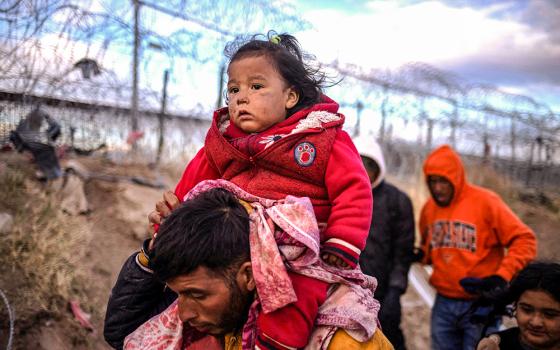Fortunately, I've been reading newspapers. Otherwise, I may have missed the major story of the 21st century: The woman's movement is over, I hear. And from a reputable source: young women in this country who consider their mother's concerns for the role and status of women to be "so passé" as one young woman on a recent CNN International interview put it in regard to the present election season in the USA.
But, just back from India, I find myself having to deal with another dimension of the question called "When is a problem not a problem?" And one part of the answer, at least, may be, "When it's not yours."
Never discount the role of distance in the valuation of the human enterprise, however. There is a point at which simply being "human" together is not enough to bridge the distinctions of life. Every place has its own "culture" -- it's own pace and food, customs and social expectations, filters and ideals. And culture is no small part of what it means to be human. To rate our own circumstances as the norm, then, can be a very chancy exercise, indeed.
If I ever saw culture in tension with ideals, for instance, it was in India where the Global Peace Initiative of Women launched an international conference titled "Making Way for the Feminine for the Good of the World."
Here was a culture that both embodied and contradicted the very concept of the role of the feminine in society at one and the same time. Here was tension enough between the ideal and the actual to make a person question the humanity of the human race.
Religious figures there talked about "Oneness," the Hindu principle of the inseparability of all beings, both genders, all persons, all peoples, and the goddesses whose gifts form the backbone of Hindu civilization. The Indian Daily Times, on the other hand, trumpeted the differences between what is true and what is actual for women with blaring cacophony and troubling regularity. Tension between the ideal and the real, we learned -- between the status of goddesses and the status of women -- was not the exception; it was the rule. The stories of women belie the religious images of women and beg the question why.
A teenage dalit girl, for instance, who had gone outside "to answer nature's call" died after four young men doused her with kerosene and set her ablaze for daring to protest their previous molestations. Local residents and party officials blame police for failing to protect women. (Sunday Hindustan Times, March 9) The good news? It is, at least, now a crime to murder a woman, even one of the "untouchables." The bad news? The public and blatant murder of women is still common.
The airlines celebrated International Women's Day by flying the Kingfisher Airbus A-320 from Delhi to Bangalore with an all-women crew. The good news? Some few women have had the opportunity to receive that kind of education. The bad news, two-thirds of the children not in school in India are female. (Hindustand Times, March 9)
According to Renuka Chowdhury, Women and Child Development Ministry of India, "over 6,000 dowry deaths were reported every year between 2004 and 2006" in India. (The Times of India, New Delhi, March 12) Translation: Women whose dowries were considered too small by the groom and his family were murdered in order to give the groom the opportunity to marry again. And get another dowry.
In one case, the young woman from whose parents the groom demanded a four wheeler van, committed suicide. (The Times of India, March 6)
The number of cases registered under "crimes against women by husband or relatives in 2006" was 164,765 -- an increase of almost 10,000 over the two years before it. The good news? Some women are registering the family abuse that comes with marriage. The bad news? Most of the women of India have no recourse at all either to legal help or to police protection, let alone the literacy to pursue the issues at higher levels.
Or more to the point: The few laws designed to protect women that are on the books, in other words, are more about myth than meaning. Without the education of both women and men, without a literate female population that is essential to changing social attitudes of a culture, women go on at the mercy of the males around them.
In another of the daily articles on the abuse of women, 30 percent of the 5,035 suicide cases in the state of Ghujarat, were housewives. Worse, the number of female suicides are rising yearly. "Recent studies," according to Ila Pathak of Ahmedabad Women's Action Group, "have indicated that 78 percent of the women in the state are subjected to domestic violence in their marriages. This has serious bearing on the psyche of the women who feel trapped since she cannot live in an abusive environment. But in most cases is not welcomed by her parents. Suicide then remains the only alternative." The good news? They're counting the women who die. The bad news? Counting the dead after years of ignoring them is not stopping the problems.
At the end of the Global Peace Initiative of Women conference, the 450 delegates said their three major commitments to women were 1) Education for and about women; 2) Support for and to women in leadership and 3) A respect for Oneness that creates respect and reverence for differences.
Maybe. But back here where we're told by women who have jobs, have status, and have money that the women's movement is "passé" now, there are some other questions to answer.
First, is there anything about the status of women that we're not seeing in our own culture, whatever ideals we promote both spiritually and politically? And second, if women here are really equal to men in power and economic security and social standing, what are our younger liberated women doing to help the rest of the women of the world reach the same status they have?
Whatever the philosophical tensions in our own life, whatever the issues to be brought to the discussion of the status of women, there is an image burned into my mind that simply will not go away. As we drove across the country, we passed through one village after another, all of them engaged in a common work -- brick making, cement carving, selling dung fuel, goat herding. The last village was a village of painted-up, prettied up prostitutes who surrounded the van looking for work. The oldest prostitute was at most 13. Selling the girls to the army camp down the road was the business of that village, the driver said matter-of-factly. After all, they were only girl children. What else were they worth?
From where I stand, I think we ought to look again at the question of whether or not the women's movement is over, should be over, can ever be over unless and until smart women do something about it everywhere. Why? Because, according to Elisabeth Bumiller in her May You Be the Mother of A Hundred Sons: A Journey Among the Women of India two-thirds of the women of the world live in villages, that's why.




